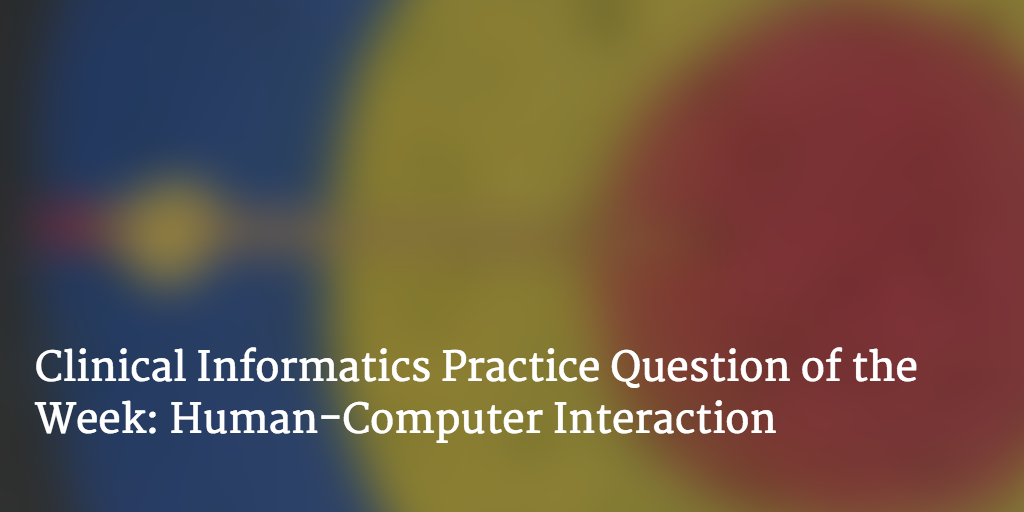We took a break from our practice question of the week last week to work on putting together our clinical informatics study package. But we’re back this week and we’re talking about some of the theories in Human-Computer Interaction.
You could spend an entire research career on just one of these topics within HCI, but in the interest of time and getting ready to take the exam, we’re going to distill these concepts down to the very very basics.
In the Core Content
- 3.2. Human Factors Engineering
- 3.2.1. Models, theories, and practices of human-computer (machine) interaction (HCI)
- 3.2.2. HCI Evaluation, usability testing, study design and methods
- 3.2.3. Interface design standards and design principles
- 3.2.4. Usability engineering
As you may already know, Human-Computer Interaction (HCI) is the field concerned with how humans and computers interact with one another. It combines elements of many disciplines such as psychology, design, programming, math, linguistics, communications, and architecture.
HCI is not just about what a Graphical User Interface (GUI) looks like. It goes deeper using scientific (and sometimes non-scientific) research and testing to produce better and more efficient interactions between human and computer.
Within HCI, models and theories help researchers predict interactions and modify their software and design accordingly. There are predictive models, descriptive models, explanatory theories, generative theories, and predictive theories.
But as always, we don’t want to give away too much before we get to the actual question, so let’s get in to it.
Question
A UI/UX engineer is laying out a menu for a patient portal. They want to model how long it will take a user to find the “Message Your Physician” menu option. Which of the following models or theories would the engineer need to use to model this action?
A. Fitt’s Law
B. Guiard’s Model
C. GOMS
D. Hick’s Law
Answer and Explanation
Fitt’s Law – A predictive model that uses math to simplify reality. Fitt’s law describes how much time it will take to move to a target area depending on the distance and size of the target – which in HCI is frequently used to predict mouse movement and time to click on something.
Faster mouse – often less accurate mouse movement. Bigger button – often more accurate mouse movement.
Guiard’s Model – A descriptive model that is more metaphoric and less mathematical than a predictive model. Guiard’s Model identifies the actions and roles of the dominant and non-dominant hand. Guiard found that most activities required an asymmetrical usage of dominant and non-dominant (or preferred and non-preferred) hands.
GOMS (Goals, Operators, Methods, Selectors) is a model for observing HCI. GOMS breaks down a user’s interaction with the computer into four main components:
- Goals: what does the user want to accomplish?
- Operators: actions to reach the goal
- Methods: sequences of operators to reach the goal
- Selectors: rules that describe when a user would pick one action over another
Hick’s Law – A predictive model that describes how long it takes for someone to make a decision depending on how many choices they have. In menu design, Hick’s law explains why a user that has many descriptive options in menu choices may take more time to make their decision, while fewer options result in a faster decision for a navigation target.
Therefore, D – Hick’s Law is the model that the UI/UX engineer would use to model decision time for a user choosing from multiple menu options.
More Learning
We hope you got this week’s question right. If you’re looking for more questions, check out our archive or come visit us every Thursday.
If you’re studying for the exam and looking for more resource on clinical informatics, you can purchase our text – Clinical Informatics Board Review: Pass the Exam the First Time. It’s the only board review book for the clinical informatics exam and comes with a money back guarantee if you don’t pass the exam on your first attempt – it’s the only study material for the clinical informatics exam with one.
You can also sign up for practice questions through learn.informaticspro.com if you’re looking to test your readiness for the exam. A full-length practice exam is now available in beta mode.
References & Resources
Models and Theories in Human-Computer Interaction. http://en.wikibooks.org/wiki/Models_and_Theories_in_Human-Computer_Interaction
